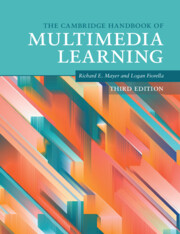Book contents
- The Cambridge Handbook of Multimedia Learning
- The Cambridge Handbook of Multimedia Learning
- Copyright page
- Contents
- Figures
- Tables
- Contributors
- Preface
- Acknowledgments
- Part I Background
- Part II Theoretical Foundations
- Part III Basic Principles of Multimedia Learning
- Part IV Principles for Reducing Extraneous Processing in Multimedia Learning
- Part V Principles for Managing Essential Processing in Multimedia Learning
- Part VI Principles Based on Social and Affective Features of Multimedia Learning
- 22 Principles Based on Social Cues in Multimedia Learning
- 23 The Embodiment Principle in Multimedia Learning
- 24 The Immersion Principle in Multimedia Learning
- 25 The Collaboration Principle in Multimedia Learning
- 26 The Animation Composition Principle in Multimedia Learning
- 27 The Emotional Design Principle in Multimedia Learning
- Part VII Principles Based on Generative Activity in Multimedia Learning
- Part VIII Multimedia Learning with Media
- Author Index
- Subject Index
- References
26 - The Animation Composition Principle in Multimedia Learning
from Part VI - Principles Based on Social and Affective Features of Multimedia Learning
Published online by Cambridge University Press: 19 November 2021
- The Cambridge Handbook of Multimedia Learning
- The Cambridge Handbook of Multimedia Learning
- Copyright page
- Contents
- Figures
- Tables
- Contributors
- Preface
- Acknowledgments
- Part I Background
- Part II Theoretical Foundations
- Part III Basic Principles of Multimedia Learning
- Part IV Principles for Reducing Extraneous Processing in Multimedia Learning
- Part V Principles for Managing Essential Processing in Multimedia Learning
- Part VI Principles Based on Social and Affective Features of Multimedia Learning
- 22 Principles Based on Social Cues in Multimedia Learning
- 23 The Embodiment Principle in Multimedia Learning
- 24 The Immersion Principle in Multimedia Learning
- 25 The Collaboration Principle in Multimedia Learning
- 26 The Animation Composition Principle in Multimedia Learning
- 27 The Emotional Design Principle in Multimedia Learning
- Part VII Principles Based on Generative Activity in Multimedia Learning
- Part VIII Multimedia Learning with Media
- Author Index
- Subject Index
- References
Summary
Research has shown that animated graphics are not the educational magic bullet that many expected them to be. They are neither necessarily superior to static graphics nor intrinsically effective in their own right. The Animation Composition Principle characterizes learning from animation as a hierarchical relation-building process by which mental models of the depicted subject matter are progressively and cumulatively constructed from discrete information primitives. It helps explain the limited success of previous attempts to improve animation’s effectiveness that took no account of their fundamental design. By giving due consideration to both perceptual and cognitive aspects of animation processing, the Animation Processing Model that embodies this Principle opens the door to novel, more effective compositional design options. These compositional animations significantly improve learning outcomes.
- Type
- Chapter
- Information
- The Cambridge Handbook of Multimedia Learning , pp. 313 - 323Publisher: Cambridge University PressPrint publication year: 2021
References
- 3
- Cited by



